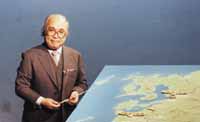|
Documentaries
In 1964, a new form of human-interest documentary
series was launched under the title A Life.
The first program, Dr. Ryokan, told
the story of a practicing doctor working to improve the local environment.
Focusing on ordinary people, the series turned a respectful gaze on
people living everyday life to the full. The series gave birth to classic
works like The Daydreaming Serpent,
the story of a teacher who dedicated his life to children's education
on a very remote island, and The Slag Heap,
about a retired coal miner who had recorded his life in 300 paintings.
Ringing in the Ears featured an A-bomb victim with radiation
sickness who published an anthology of poems about the horror of the
attack. Emigration followed a farming
couple from Iwate Prefecture as they prepared to emigrate to Paraguay
at almost 70 years of age. The director of that program, Aida Yutaka,
continued to record their story for more than 30 years.
The style of the human-interest documentary
was carried over to Reportage Japan,
a series that began in 1978. The series used young reporters with a
keen interest in contemporary social issues to investigate the causes
and consequences of current events. The programs served as an on-the-spot
witness in The Survival of Schools,
when former Minister of Education Nagai Michio visited a high school
that was reaching out to high school dropouts, when Nakagami Kenji looked
at the Birth of a Rightist, and in
filmmaker Oshima Nagisa's Caught in the Act,
which dealt with the actual moment of shoplifting. Many programs depicted
the changing times through their timely reporting of events and incidents.
Yamaguchi-gumi, Summer '78 featured
an interview with the head of a criminal syndicate during an outbreak
of mob violence. Report: Airlifting Corpses
investigated the increasing number of Japanese deaths overseas and the
silent return of the bodies to Japan.
In 1985, the travelogue became a new documentary
format, exemplified by 30,000 km Voyage around
Japan, a continuous circumnavigation of the country's coastline.
Blending scenery, history and people, the program chronicled the benefits
and dangers in the long relationship between the sea and the people
of Japan.
|
|
History programs
The series Exploring
Japanese History began regular broadcasts in 1970. Focusing on
particular historical individuals and events, it reconsidered Japanese
history through lively discussions among distinguished historians and
writers like Kaionji Chogoro, Matsumoto Seicho, Yamaoka Sohachi, and
Shiba Ryotaro. These contributors made history come to life by discussing
the feelings and motives of those involved in a given event, and the
lesson it could offer the modern world.
 Doorway to History
Doorway to History |
The format of history programs changed
in 1978 with the launch of Doorway to History,
which cast a rigorous contemporary analytical eye on significant events
from the past. The second episode, 80,000
Samurai, dealt with the fate of the Tokugawa shogun's retainers,
who gave armed service to the family from the founding shogun's early
years as an obscure regional warlord. The program used various historical
materials to show how the long peace had made these fighters redundant,
and to answer such down-to-earth questions from viewers as "How
much money did the vendetta of the 47 loyal retainers cost?" and
"What kind of horses did Yoshitsune's cavalry ride?" It was
the first history program to investigate the folk heroes Ishikawa Goemon
(a legendary ninja bandit), Shimizu-no Jirocho (a Japanese Robin Hood),
and Nezumi-kozo Jirokichi (a master thief said to be as nimble as a
mouse). The show was hosted by the popular announcer Suzuki Kenji, whose
smooth delivery could make even convoluted phrases sound graceful and
lucid.
|
Kaionji: a regular explorer
The most frequently appearing guest on Exploring
Japanese History was Kaionji Chogoro, noted for his deft
contributions. Here, for instance, is his comment on the famous
rival warlords Uesugi Kenshin and Takeda Shingen: "The first
thing to notice about their clash at Kawanakajima is how beautiful
it was. Both Uesugi and Takeda possessed the elegance of accomplished
dancers. From time to time the gods deign to give us such exceptional
individuals, so that they can orchestrate an epic spectacle."
The guests on the program were giants of the historical fiction
field who brought history to life with wit and insight.
|
|


